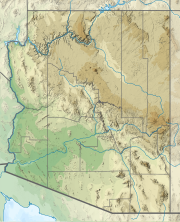| Strawberry Crater | |
|---|---|
 | |
| Highest point | |
| Elevation | 6,526 ft (1,989 m) NGVD 29[1] |
| Prominence | 476 ft (145 m)[1] |
| Coordinates | 35°26′32″N 111°28′13″W / 35.4422285°N 111.4701542°W[2] |
| Geography | |
| Location | Coconino County, Arizona, U.S. |
| Topo map | USGS Strawberry Crater |
| Geology | |
| Mountain type | cinder cone |
| Volcanic field | San Francisco volcanic field |
| Climbing | |
| Easiest route | Trail hike[3] |
| Strawberry Crater Wilderness | |
|---|---|
| Location | Coconino County, Arizona, U.S. |
| Nearest city | Flagstaff |
| Coordinates | 35°25′49″N 111°25′49″W / 35.4304136°N 111.4303137°W[4] |
| Area | 10,141 acres (4,104 ha)[5] |
| Established | 1984 |
| Administrator | Coconino National Forest U.S. Forest Service |

Strawberry Crater is a cinder cone volcano, more than 1,000 feet (300 m) high, in the San Francisco volcanic field, 20 miles (32 km) north of Flagstaff, Arizona.[6] It is along Forest Road 545 between the Wupatki National Monument and Sunset Crater National Monument in the Strawberry Crater Wilderness.[5] The crater lies in a volcanic field at a base elevation of about 5,500 feet (1,700 m), and prominence heights of about 6,526 feet (1,989 m). The northwestern end of the crater is covered with lava flows, while the southern end is filled with low cinder cones. Several of the surrounding cones include the better known, taller and younger Sunset Crater[7][8] in the adjacent Sunset Crater National Monument.
The wilderness area that includes Strawberry Crater covers 10,743 acres (4,348 ha), consisting mainly of hills, cinder cones, and arid terrain ranging in elevation from 5,500 to 6,000 feet (1,700 to 1,800 m). The surface landforms are about 50,000 to 100,000 years old.[9]
- ^ a b "Strawberry Crater AZ". ListsOfJohn.com. Retrieved 2016-08-24.
- ^ "Strawberry Crater". Geographic Names Information System. United States Geological Survey, United States Department of the Interior. Retrieved 2016-08-24.
- ^ "Strawberry Crater Trail". Retrieved 2016-08-24.
- ^ "Strawberry Crater Wilderness". Geographic Names Information System. United States Geological Survey, United States Department of the Interior. Retrieved 2016-08-24.
- ^ a b "Strawberry Crater Wilderness". U.S. Forest Service. Retrieved 2013-05-04.
- ^ Warren, Scott S. (1996). Exploring Arizona's Wild Areas. Seattle: The Mountaineers Books. ISBN 0898864704.
- ^ Priest, Susan S.; et al. "The San Francisco Volcanic Field, Arizona". U.S. Geological Survey. Retrieved 2013-05-04.
- ^ Magnum, Richard K.; Magnum, Sherry G. (2001). Flagstaff Hikes. Flagstaff: Hexagon Press. ISBN 1891517503.
- ^ Wilderness Institute. "Strawberry Crater Wilderness". University of Montana. Retrieved 2013-05-04.

